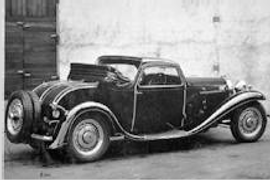Body style: Coupé (two-door)
Segment: Roadster & Convertible
Production years: 1930, 1931, 1932, 1933, 1934

In 1930, despite the Great Depression that started in late 1929, Bugatti introduced the Type 50, a sportscar built on top of the same chassis as the Type 46 but with several essential upgrades.
Jean Bugatti persuaded his father, Ettore, to create an even better and faster car based on the chassis developed for the Type 46. They took inspiration from the Miller racing cars that competed in the 1929 Moza race, and as a result, in late 1939, the Type 50 appeared on the market. Most vehicles were bodied by other coachbuilders, which was common for that era. The new vehicle was built in just 65 units. Bugatti entered three of them at the 1931 24 Hours of Le Mans race. Even though neither finished the race, the Type 50 improved Bugatti’s image on the sports car market. Eventually, the automaker won that endurance race in 1937. Still, the car proved that it could run fast. It was so fast that the British Bugatti Agency was afraid to sell the vehicle in UK due to the narrow roads.
Regardless of who completed the car, they all sported the same front fascia, which was part of the rolling chassis sold by the French automaker. All of them wore the horse-shoe shape of the radiator. In front of it, the car manufacturer installed the headlights supported by a chromed horizontal bar mounted on the inner sides of the front fenders. The chassis was extended forward and supported the metallic bumper, showing the manufacturer’s concern about safety. In addition, Bugatti installed additional headlamps on top of the front fenders.
From its profile, the long and tall hood could be opened via side-mounted panels that featured louvers for cooling. The engine compartment was flanked by valanced fenders extended to the side steps that made ingress and egress easier. Due to the short wheelbase, the Type 50 was produced only as a two-door vehicle, either as a coupe or a convertible, depending on the customer’s options. The rear wheel fenders were slim and supported the stalks for the taillights. Finally, at the back, the curved rear end sported a pair of spare wheels.
Since it was a personal luxury vehicle, most customers chose expensive materials for the seats. Still, the dashboard was delivered by Bugatti as part of the rolling chassis. It featured a wooden dash panel that sported the dials in the middle, while the driver fronted just the big, four-spoke steering wheel. The floor-mounted gear stick and the hand brake were mounted on the floor between the driver and the side passenger. Some coupe vehicles featured a third, side-facing seat in the back, which could host a third person for short distances.
But the most essential part of the car was under the hood. After studying the engines of Miller race cars, Bugatti noticed that the hemispherical combustion chambers and the inclined valves offered higher performance. He combined that technology with the twin-cam system and then added a supercharger. As a result, the five-liter inline-eight powerplant developed a breathtaking power of 225 PS (223 hp) sent to the rear wheels via a three-speed manual gearbox. Bugatti used drum brakes for all four wheels to stop the vehicle.
BUGATTI Type 50 1930, 1931, 1932, 1933, 1934
- 5.0
BUGATTI Type 50
5.0
ENGINE SPECS - 5.0 | |
|---|---|
| Cylinders: | L8 |
| Displacement: | 4972 cm3 |
| Power: | 166 KW @ 4000 RPM 225 HP @ 4000 RPM 223 BHP @ 4000 RPM |
| Fuel System: | Carburetors |
| Fuel: | Gasoline |
TRANSMISSION SPECS | |
|---|---|
| Drive Type: | Rear Wheel Drive |
| Gearbox: | Manual, 3 Speed |
BRAKES SPECS | |
|---|---|
| Front: | Drums |
| Rear: | Drums |
TIRES SPECS | |
|---|---|
| Tire Size: | 20 X 6.5 |
DIMENSIONS | |
|---|---|
| Front/rear Track: | 55.1/55.1 in (1,400/1,400 mm) |
| Wheelbase: | 122 in (3099 mm) |
WEIGHT SPECS | |
|---|---|
| Unladen Weight: | 3306.9 lbs (1500 kg) |